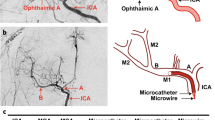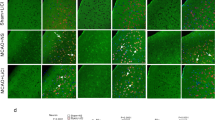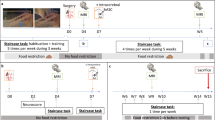Abstract
All attempts at treating strokes by pharmacologically reducing the human brain’s vulnerability to ischaemia have failed, leaving stroke as a leading cause of death, disability and massive socioeconomic loss worldwide1. Over decades, research has failed to translate over 1,000 experimental treatments from discovery in cells and rodents to use in humans2,3,4, a scientific crisis that gave rise to the prevailing belief that pharmacological neuroprotection is not feasible or practicable in higher-order brains. To provide a strategy for advancing stroke therapy, we used higher-order gyrencephalic non-human primates, which bear genetic, anatomical and behavioural similarities to humans5,6 and tested neuroprotection by PSD-95 inhibitors—promising compounds that uncouple postsynaptic density protein PSD-95 from neurotoxic signalling pathways7,8,9,10. Here we show that stroke damage can be prevented in non-human primates in which a PSD-95 inhibitor is administered after stroke onset in clinically relevant situations. This treatment reduced infarct volumes as gauged by magnetic resonance imaging and histology, preserved the capacity of ischaemic cells to maintain gene transcription in genome-wide screens of ischaemic brain tissue, and significantly preserved neurological function in neurobehavioural assays. The degree of tissue neuroprotection by magnetic resonance imaging corresponded strongly to the preservation of neurological function, supporting the intuitive but unproven dictum that integrity of brain tissue can reflect functional outcome. Our findings establish that tissue neuroprotection and improved functional outcome after stroke is unequivocally achievable in gyrencephalic non-human primates treated with PSD-95 inhibitors. Efforts must ensue to translate these findings to humans.
This is a preview of subscription content, access via your institution
Access options
Subscribe to this journal
Receive 51 print issues and online access
$199.00 per year
only $3.90 per issue
Buy this article
- Purchase on Springer Link
- Instant access to full article PDF
Prices may be subject to local taxes which are calculated during checkout




Similar content being viewed by others
References
Roger, V. L. et al. Heart disease and stroke statistics—2011 update: a report from the American Heart Association. Circulation 123, e18–e209 (2011)
Anon The bitterest pill. Nature 444, 532–533 (2006)
O’Collins, V. E. et al. 1,026 experimental treatments in acute stroke. Ann. Neurol. 59, 467–477 (2006)
Sacchetti, M. L. Is it time to definitely abandon neuroprotection in acute ischemic stroke? Stroke 39, 1659–1660 (2008)
Courtine, G. et al. Can experiments in nonhuman primates expedite the translation of treatments for spinal cord injury in humans? Nature Med. 13, 561–566 (2007)
Enard, D., Depaulis, F. & Roest Crollius, H. Human and non-human primate genomes share hotspots of positive selection. PLoS Genet. 6, e1000840 (2010)
Aarts, M. et al. Treatment of ischemic brain damage by perturbing NMDA receptor-PSD-95 protein interactions. Science 298, 846–850 (2002)
Sattler, R. et al. Specific coupling of NMDA receptor activation to nitric oxide neurotoxicity by PSD-95 protein. Science 284, 1845–1848 (1999)
Soriano, F. X. et al. Specific targeting of pro-death NMDA receptor signals with differing reliance on the NR2B PDZ ligand. J. Neurosci. 28, 10696–10710 (2008)
Sun, H. S. et al. Effectiveness of PSD-95 inhibitors in permanent and transient focal ischemia in the rat. Stroke 39, 2544–2553 (2008)
Roitberg, B. et al. Chronic ischemic stroke model in cynomolgus monkeys: behavioral, neuroimaging and anatomical study. Neurol. Res. 25, 68–78 (2003)
Fisher, M. The ischemic penumbra: identification, evolution and treatment concepts. Cerebrovasc. Dis. 17 (suppl. 1). 1–6 (2004)
Bardutzky, J. et al. Characterizing tissue fate after transient cerebral ischemia of varying duration using quantitative diffusion and perfusion imaging. Stroke 38, 1336–1344 (2007)
Fisher, M. et al. Update of the stroke therapy academic industry roundtable preclinical recommendations. Stroke 40, 2244–2250 (2009)
Committee, S. Recommendations for standards regarding preclinical neuroprotective and restorative drug development. Stroke 30, 2752–2758 (1999)
Kornau, H. C., Schenker, L. T., Kennedy, M. B. & Seeburg, P. H. Domain interaction between NMDA receptor subunits and the postsynaptic density protein PSD-95. Science 269, 1737–1740 (1995)
Cui, H. et al. PDZ protein interactions underlying NMDA-receptor-mediated excitotoxicity and neuroprotection by PSD-95 inhibitors. J. Neurosci. 27, 9901–9915 (2007)
Bratane, B. T. et al. Neuroprotection by freezing ischemic penumbra evolution without cerebral blood flow augmentation with a postsynaptic density-95 protein inhibitor. Stroke 42, 3265–3270 (2011)
Marshall, J. W. & Ridley, R. M. Assessment of cognitive and motor deficits in a marmoset model of stroke. ILAR J. 44, 153–160 (2003)
Reagan-Shaw, S., Nihal, M. & Ahmad, N. Dose translation from animal to human studies revisited. FASEB J. 22, 659–661 (2008)
Brott, T. et al. Measurements of acute cerebral infarction: a clinical examination scale. Stroke 20, 864–870 (1989)
Johnston, K. C. et al. Validation of an acute ischemic stroke model: does diffusion-weighted imaging lesion volume offer a clinically significant improvement in prediction of outcome? Stroke 38, 1820–1825 (2007)
Hand, P. J. et al. MR diffusion-weighted imaging and outcome prediction after ischemic stroke. Neurology 66, 1159–1163 (2006)
Yanagihara, T. Experimental stroke in gerbils: effect on translation and transcription. Brain Res. 158, 435–444 (1978)
Hacke, W. et al. Association of outcome with early stroke treatment: pooled analysis of ATLANTIS, ECASS, and NINDS rt-PA stroke trials. Lancet 363, 768–774 (2004)
Hacke, W. et al. Thrombolysis with alteplase 3 to 4.5 hours after acute ischemic stroke. N. Engl. J. Med. 359, 1317–1329 (2008)
Sanossian, N. et al. Simultaneous ring voice-over-Internet phone system enables rapid physician elicitation of explicit informed consent in prehospital stroke treatment trials. Cerebrovasc. Dis. 28, 539–544 (2009)
The National Institute of Neurological Disorders and Stroke rt-PA Stroke Study Group Tissue plasminogen activator for acute ischemic stroke. The National Institute of Neurological Disorders and Stroke rt-PA Stroke Study Group. N. Engl. J. Med. 333, 1581–1587 (1995)
Savitz, S. I. & Fisher, M. Future of neuroprotection for acute stroke: in the aftermath of the SAINT trials. Ann. Neurol. 61, 396–402 (2007)
Savitz, S. I. A critical appraisal of the NXY-059 neuroprotection studies for acute stroke: a need for more rigorous testing of neuroprotective agents in animal models of stroke. Exp. Neurol. 205, 20–25 (2007)
Findlay, J. M., Macdonald, R. L., Weir, B. K. & Grace, M. G. Surgical manipulation of primate cerebral arteries in established vasospasm. J. Neurosurg. 75, 425–432 (1991)
Kosior, J. C. & Frayne, R. PerfTool: a software platform for investigating bolus-tracking perfusion imaging quantification strategies. J. Magn. Reson. Imaging 25, 653–659 (2007)
Stewart, C. B. & Disotell, T. R. Primate evolution – in and out of Africa. Curr. Biol. 8, R582–R588 (1998)
Kobasa, D. et al. Aberrant innate immune response in lethal infection of macaques with the 1918 influenza virus. Nature 445, 319–323 (2007)
Gibbs, R. A. et al. Evolutionary and biomedical insights from the rhesus macaque genome. Science 316, 222–234 (2007)
Draghici, S. et al. A systems biology approach for pathway level analysis. Genome Res. 17, 1537–1545 (2007)
Marshall, J. W. & Ridley, R. M. Assessment of functional impairment following permanent middle cerebral artery occlusion in a non-human primate species. Neurodegeneration 5, 275–286 (1996)
Acknowledgements
This work was supported by grants to M.T. from the Canadian Stroke Network and the Heart and Stroke Foundation of Ontario, grant NA 6988. D.J.C. is a recipient of a Canadian Stroke Network postdoctoral research fellowship. M.T. is a Canada Research Chair (Tier 1) in Translational Stroke Research. We thank M. Madden, B. Maloo, A. Goldstein, B. Madeira, W. Foltz and Z. Lu for assistance. We thank M. Salter and M. Hill for a review of the manuscript.
Author information
Authors and Affiliations
Contributions
D.C. and M.T. performed the experimental procedures, collected and analysed the data and drafted the manuscript. L.T. performed experimental procedures and data collection.
Corresponding author
Ethics declarations
Competing interests
M.T. is president of NoNO Inc., a biotechnology company founded to develop PSD-95 inhibitors discovered in his research laboratory.
Supplementary information
Supplementary Information
This file contains Supplementary Figures 1-6 with legends, Supplementary Methods, a Supplementary Discussion, Supplementary Tables 1-4 and Supplementary References. (PDF 5966 kb)
Rights and permissions
About this article
Cite this article
Cook, D., Teves, L. & Tymianski, M. Treatment of stroke with a PSD-95 inhibitor in the gyrencephalic primate brain. Nature 483, 213–217 (2012). https://doi.org/10.1038/nature10841
Received:
Accepted:
Published:
Issue Date:
DOI: https://doi.org/10.1038/nature10841
This article is cited by
-
Spontaneous Behavioural Recovery Following Stroke Relates to the Integrity of Parietal and Temporal Regions
Translational Stroke Research (2024)
-
Evolving Stroke Systems of Care: Stroke Diagnosis and Treatment in the Post-Thrombectomy Era
Neurotherapeutics (2023)
-
The Vessel Has Been Recanalized: Now What?
Neurotherapeutics (2023)
-
The neuroprotective mechanism of lithium after ischaemic stroke
Communications Biology (2022)
-
A clinically relevant model of focal embolic cerebral ischemia by thrombus and thrombolysis in rhesus monkeys
Nature Protocols (2022)
Comments
By submitting a comment you agree to abide by our Terms and Community Guidelines. If you find something abusive or that does not comply with our terms or guidelines please flag it as inappropriate.



